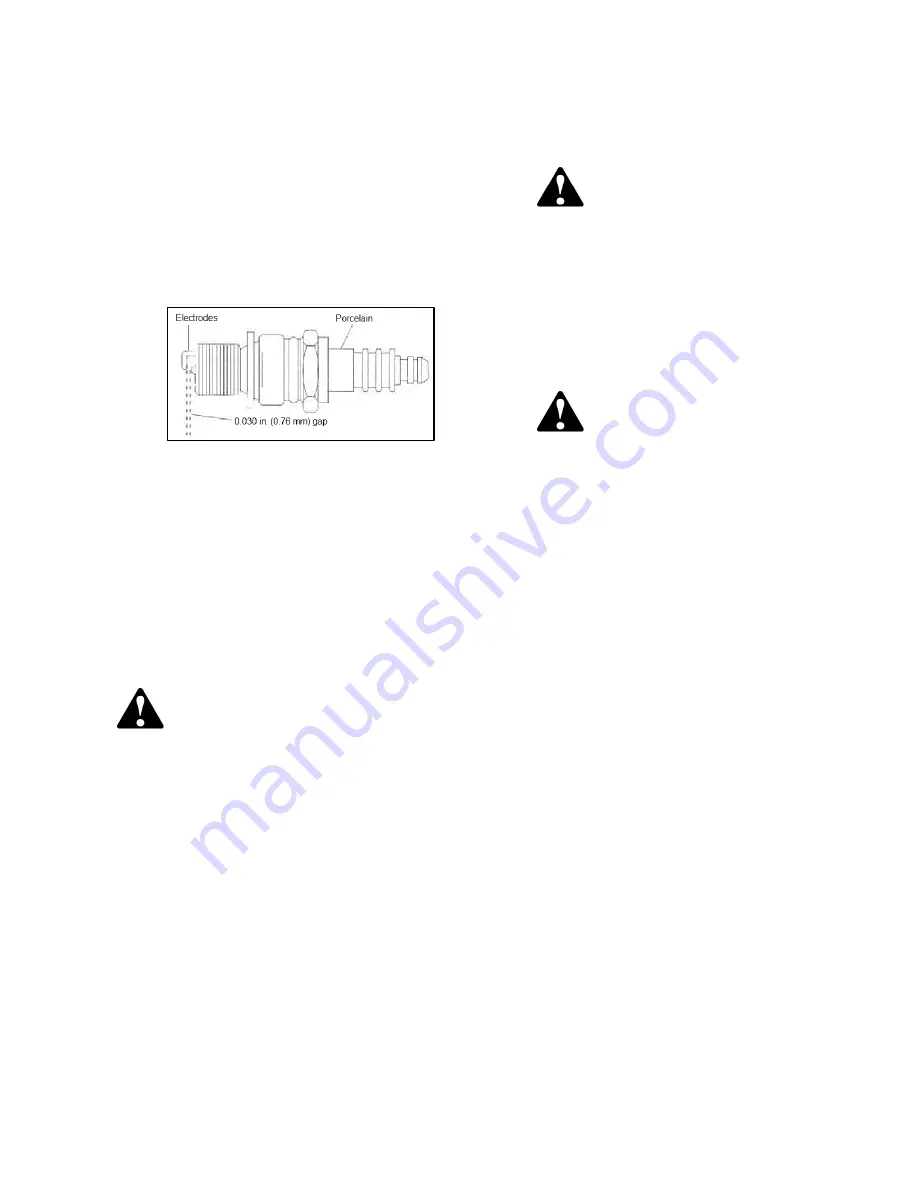
14
Checking the Spark Plug
Check the spark plug annually, or after every 100
hours of use.
1. Clean the area around the spark plug.
2. Remove and inspect the spark plug.
3. Replace the spark plug if its porcelain is
cracked or if its electrodes are pitted, burned
or fouled with deposits.
4. Check the electrode gap with a feeler gauge
and set the gap to .030 inches (0.76mm) if
necessary.
5. Reinstall the spark plug and tighten it securely.
NOTE
: A resistor spark plug must be used for
replacement. Contact an Authorized Parts and
Repair Center for a replacement spark plug.
Off-Season Storage
Preparing Engine
WARNING: Never store the snow blower with
fuel in its tank indoors, or in poorly ventilated
areas where the fuel fumes may reach an open
flame, spark or pilot light.
NOTE
: It is important to prevent gum deposits from
forming in essential fuel system parts of the engine,
such as the carburetor, fuel filter, fuel hose or tank,
during storage.
CAUTION
: Alcohol blended fuels (called gasohol),
ethanol or methanol can attract moisture which
leads to separation and formation of acids during
storage. Acidic gas can damage the fuel system of
an engine while in storage.
To avoid engine problems, the fuel system should
be emptied before storage for 30 days or longer.
Follow these instructions to prepare your snow
blower for storage:
1. Remove all gasoline from the carburetor
and fuel tank to prevent gum deposits from
forming on these and damaging the engine.
WARNING: Drain fuel into an
approved container outdoors, away from
any open flame. Be certain the engine is
cool. Do not smoke. Fuel left in an engine
during warm weather may deteriorate and
cause serious starting problems.
2. Run the engine until the fuel tank is empty
and it stops due to a lack of fuel.
3. Drain the carburetor by pressing upward on
the
bowl
drain
(located
below
the
carburetor cover).
WARNING: Do not drain the
carburetor when using fuel stabilizer.
Never use engine or carburetor cleaning
products in the fuel tank or permanent
damage may occur.
NOTE
: Fuel stabilizer (such as STA-BIL) is
an acceptable alternative in minimizing the
formation of fuel gum deposits during
storage. Add such stabilizers to gasoline in
a fuel tank or storage container. Always
follow the mix ratio found on the stabilizer
container. Run the engine at least 10
minutes after adding stabilizer to allow it to
reach the carburetor.
4. Remove the spark plug and pour 1 ounce
of engine oil through the spark hole and
into the cylinder.
5. Cover the spark plug hole with a rag and
crank the engine several times to distribute
the oil.
6. Replace the spark plug.
Preparing the Snow Blower for Storage
1. When storing the snow blower in an
unventilated or metal storage shed, be sure
to rustproof the machine. Coat the equipment
and especially any chains, springs, bearings
and cables, by using a light oil or silicone.
2. Remove all dirt from the exterior of the
engine and equipment.
3. Follow the lubrication recommendations in
the
“Maintenance” section of this manual.
4. Store the equipment in a clean dry area.
































